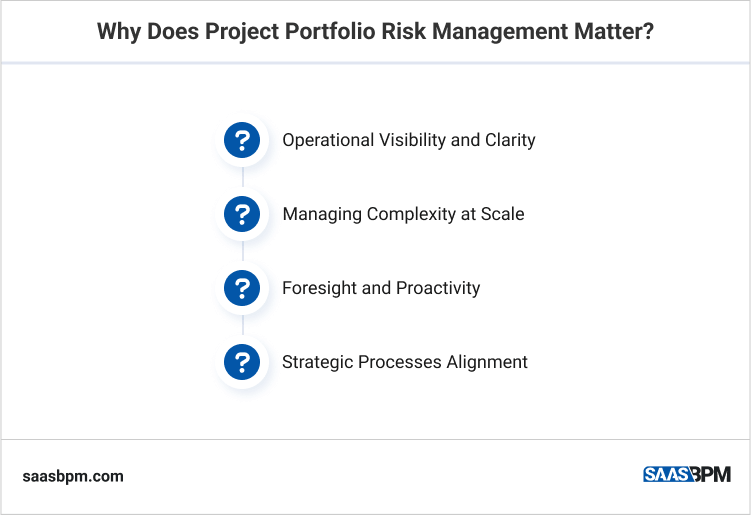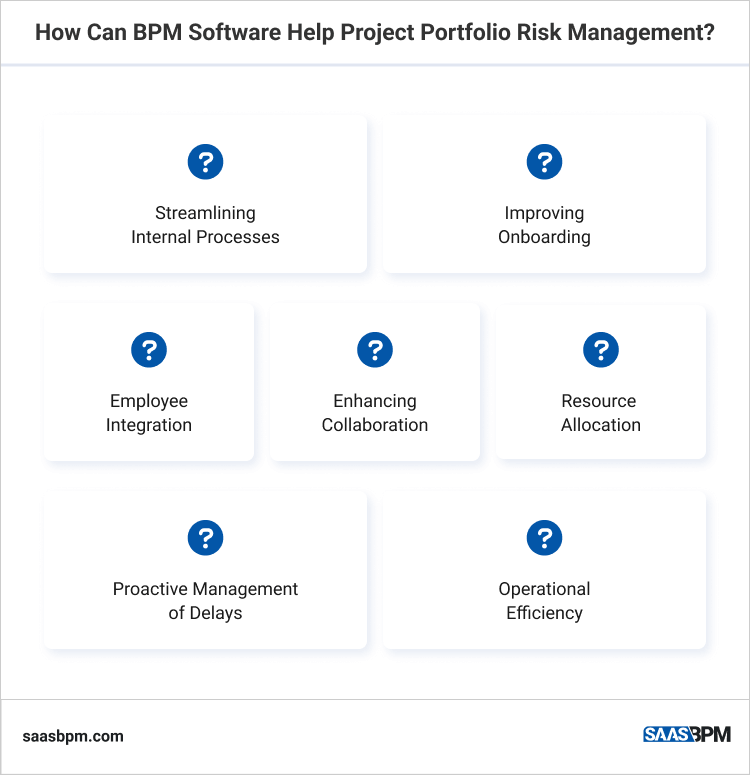Project portfolio risk management is the process of identifying and mitigating risks across all the projects a company handles i.e. its portfolio.
As a business process management software provider specializing in solutions for small businesses, we at SaaS BPM understand that managing multiple projects simultaneously can be a daunting task. It involves balancing resources, timing, and priorities while also navigating the uncertainties that can throw these variables off course.
Effective project portfolio risk management not only safeguards your projects against potential pitfalls but also ensures that they align with your overall business strategy, maximizing your organization’s performance and resilience.
In this article, we will delve into the importance of this practice, the methodologies involved, and how small businesses can effectively implement these strategies to achieve sustained success.
Why Does Project Portfolio Risk Management Matter?

Project portfolio risk management, or as many refer to it, project portfolio management (PPM), is crucial for organizations looking to improve operational visibility, enhance decision-making, and align projects with strategic goals. This comprehensive approach provides a structured framework to manage and mitigate risks across multiple projects, here’s how:
Operational Visibility and Clarity
At its core, project portfolio risk management offers a clear snapshot of project health and performance across the entire portfolio. This visibility is essential not only for maintaining the quality of project outputs but also for ensuring that projects are delivered within their deadlines and budgets.
For organizations with lower project management maturity, PPM is invaluable in setting realistic expectations regarding project timelines and budgets, leveraging insights from previous projects to avoid overambitious or under-targeted estimates.
Moreover, portfolio managers or Project Management Offices (PMOs) utilize advanced tools and processes to track progress and optimize the portfolio dynamically, enhancing the organization’s ability to meet its objectives efficiently.
Managing Complexity at Scale
As organizations grow, the complexity of managing numerous interrelated projects increases significantly. Traditional tools like Excel may suffice for small, straightforward project sets, but as the scale and complexity of project activities expand, more sophisticated PPM methods become indispensable.
These methods provide the necessary framework to handle large amounts of data and complex linkages between projects, resources, and functions. This capability is crucial for ensuring that projects are not only profitable but also strategically aligned and on track for success, thus preventing the proliferation of unconsolidated and cumbersome spreadsheets which can become a significant operational burden.
Foresight and Proactivity
Beyond current project states, a good project portfolio risk management strategy would focus on forecasting future conditions and challenges. By using predictive and prescriptive analytics, PMO managers engage in modeling and simulation of various scenarios to anticipate future costs, resource needs, and project outcomes.
This forward-looking approach allows organizations to shift from reactive to proactive management, preparing them to respond swiftly and effectively to changes or potential risks.
Moreover, a structured approach to risk management enables these organizations to identify, quantify, and mitigate risks before they jeopardize project outcomes, maintaining value at the portfolio level.
Strategic Processes Alignment
Project portfolio risk management also plays a crucial role in fostering organizational cohesion and ensuring that all projects are in line with overarching strategic objectives.
Through centralized management, PMOs can make informed decisions about project selection, prioritization, and alignment with business goals. This central oversight helps bridge gaps between different teams and functions, ensuring that everyone is working towards common objectives with clear roles and responsibilities.
Additionally, PMOs provide essential training and resources to uphold standards and best practices across all projects, enhancing the overall quality and consistency of project deliverables.
How To Manage Project Portfolio Risk
Project portfolio risk management is an ongoing process – it is not a framework you just implement once and hope it works. Although it is quite pessimistic to always be on the lookout for potential threats across your projects, it is necessary in order to prevent and avoid risks. Here are the key steps to manage project portfolio risk in your business – bear in mind that you may have to perform all of them daily.
1. Identify Risks
The first step in managing portfolio risk is to identify potential risks. This involves continuously scanning the environment and using tools like risk registers and SWOT analysis to capture both internal and external threats and opportunities. Regularly engaging with project managers, stakeholders, and teams to gather insights and feedback can also unveil risks that might not be visible at the higher levels of management.
2. Analyze Risks
Once identified, each risk must be analyzed to understand its potential impact and likelihood. This analysis helps prioritize risks based on their severity and the probability of occurrence. Techniques such as risk matrixes and qualitative and quantitative assessments are vital in this step to ensure that resources are allocated effectively to mitigate the most critical risks.
3. Plan Risk Responses
After prioritizing the risks, the next step is to plan appropriate responses. Responses can be categorized as avoiding, transferring, mitigating, or accepting the risk. Developing contingency plans and identifying triggers that might set these plans into motion are also crucial parts of this step. It’s important to ensure that these response strategies are integrated into project plans and align with the overall business strategy.
4. Implement Risk Responses
Implementing risk responses requires coordination and communication across the entire portfolio. This might involve adjusting project scopes, reallocating budgets, or changing strategic directions. Effective implementation also depends on the project managers and their teams who carry out the risk response plans on the ground, making it crucial to have skilled and responsive management in place.
5. Monitor and Review
Risk management is a dynamic process. Regular monitoring of risk triggers and the effectiveness of responses is essential. This includes tracking risk metrics and key performance indicators (KPIs) and conducting regular review meetings. Monitoring provides the necessary feedback to refine risk responses and update risk assessments based on current project and environmental conditions.
6. Communicate and Report
Effective communication and reporting mechanisms ensure that all stakeholders are kept informed about potential risks and the steps being taken to manage them. This transparency helps in managing expectations and provides a clear view of how risks are being handled at the portfolio level.
How Can SaaS BPM Help?

Business Process Management (BPM) software like SaaS BPM can significantly enhance project portfolio risk management by streamlining and automating internal processes. It helps in gaining control over chaotic workflows, reducing the likelihood of tasks being overlooked or errors occurring due to unclear internal processes. By standardizing procedures, BPM software ensures that repeatable tasks such as invoicing, following up on emails, and managing monthly bills are automated, freeing up valuable time for strategic planning.
The software also aids in improving the onboarding process for new hires by automating role-specific tasks and using visual tools like mind maps and lists to clarify responsibilities and expectations. This streamlined process not only supports new employees during their initial phase but also enhances the overall onboarding efficiency.
Moreover, BPM enhances communication and visibility across an organization. It breaks down silos between departments by ensuring that all team members have access to the same information and understand their roles within broader business processes. This clarity in communication can prevent costly misunderstandings and improve collaboration, leading to more effective project outcomes.
BPM tools also enable proactive management of delays and other issues within projects. They provide features that allow management to monitor task completion and address bottlenecks promptly, which is crucial in maintaining project timelines and avoiding risks associated with delays. Furthermore, these tools help in identifying and reallocating resources efficiently, indicating when additional personnel might be necessary to prevent task overload in any department.
Lastly, BPM software contributes to cost reduction by identifying inefficient processes that could be optimized or outsourced. Through workflow automation and better organization, it minimizes the risk of costly mistakes and enhances overall operational efficiency. By maintaining a clear overview of the company’s goals and each employee’s role in achieving them, BPM software fosters a motivated workforce, which is essential for sustained business growth and risk management.
Conclusion
Project portfolio risk management is crucial for effectively handling multiple projects and aligning them with strategic goals. Business Process Management software, like SaaS BPM, enhances this process by automating workflows, improving organizational communication, and enabling proactive management of tasks and resources. By leveraging BPM solutions, businesses can mitigate risks, optimize operations, and boost project success, leading to sustained growth and resilience in a dynamic business landscape.

